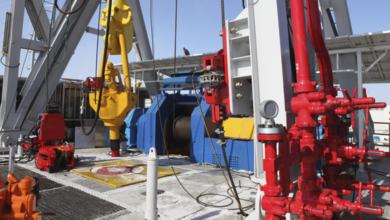D&C Tech Digest
Slim-hole drilling system added to Q4000 MODU
Helix Energy Solutions Group recently completed installation of drilling equipment on its MODU Q4000 multi-service vessel, equipped with a DP-3 system. One of its first tasks will be a deepwater logging project in the Gulf of Mexico underwritten by a consortium consisting of the US government and several energy companies. The Q4000 will drill nine open-hole wells in three deepwater locations. All wells to be logged lie in waters ranging in depth from 6,800 ft to 9,400 ft off the Louisiana coast.
The new modular-based drilling system provides a hybrid slimbore drilling capability that will allow it to efficiently drill smaller-diameter wellbores. The vessel is capable of drilling and completing wells in normally pressured reservoirs in water depths up to 6,000 ft and exploration wells in water depth in excess of 6,000 ft.
Another application will be top hole drilling, or “well initiation,” where the vessel will drill, case and cement one or more upper sections of the wellbore. The company believes this will allow operators in ultra-deepwater to use a more cost-effective drilling rig such as the Q4000 to batch set the first casing strings, then use a more expensive rig to drill deeper.
Flexible risers scanned in-situ
HESS, working with flexible pipe specialist flexlife and partners AGR Field Operations, are claiming industry history with the successful scanning of flexible risers in situ for the first time.
Hess commissioned the inspection of flexible risers on the Triton FPSO, which produces oil and gas from the Bittern and Guillemot West Area fields, as part of a campaign to investigate and assess riser integrity on its North Sea assets. The work, successfully carried out in February, utilised flexlife’s patented ultrasonic scanning technology, delivered by AGR’ Neptune device. It was carried by Film-ocean’s inspection class ROV.
flexlife launched the scanning technology with AGR last year. The AGR Neptune is the only subsea-operated technology able to scan for a flooded annulus and flexible pipe armour wire corrosion, factors that significantly affect the service life of flexible risers.
“This is the first time in the 40 years since flexibles were brought into service that it has been possible to inspect risers for a flooded annulus and be absolutely certain of the results,” said flexlife director John Marsden, who oversaw the work. “In a matter of days, we gathered the 100% accurate data on flooding for them. Our pioneering, safety-conscious solution has attracted a huge amount of interest from the industry and we are scheduled to carry out similar scanning work for more clients shortly.”
He continued: “By using this technology, operators can detect if they have a breached outer sheath and flooded annulus on a flexible riser or flowline. We can now see the armour wires through the outer sheath and measure levels of corrosion or damage.’’
High-resolution images were obtained by scanning through the riser outer sheath showing the armour wires underneath. The results were recorded using AGR’s proprietary Technology Design software and delivered in real time.
FPSOs are the main users of flexible pipe.
300th sand plug isolation placement in Canada
BJ Services announced it has placed the 300th LitePlug sand plug isolation system in Canada, during a shale gas completion in northeast British Columbia.
The system is a composite sand plug consisting of common fracturing proppant and the company’s patented LiteProp ultra-lightweight proppant or FlexSand proppant flowback additive. The consolidated material provides a stable sand plug in horizontal cased-hole completions and has been successful in providing isolation at differential pressures exceeding 6,000 psi. This isolation system offers a more efficient isolation technique compared with conventional mechanical isolation technologies, the company says.
“The 300th field application of LitePlug technology illustrates an industry shift toward more efficient horizontal multizone fracturing practices,” said Brad Rieb, BJ region technical manager.
Of the 300 LitePlug systems placed throughout Canada, more than 85% have been completed in shale reservoirs. The 300th placement involved the sequential completion of eight horizontal zones and the successful deployment of seven LitePlug isolation systems. The low-risk completion technique resulted in an estimated 20% cost reduction.
Industry gradually speeding up acceptance of new technologies; early user involvement may be key
By Katie Mazerov, contributing editor
Hydrocarbons will likely remain the world’s primary power driver for the near term, and the path to those hydrocarbons lies in technology.
“Hydrocarbons are going to be the main source of energy for the developed and emerging world for at least the next two decades, and it’s going to take technology to develop the supply to meet demand,” said Paul Ching, chairman and chief executive officer, Meridian Resource Corp, and co-chair of the SPE Emerging Technology Workshop, 19-20 May in San Antonio, Texas.
But as new technologies have emerged, the oil and gas industry has been slow to embrace them. “A study by (business consulting firm) McKenzie & Associates in the late 1990s showed that the oil industry was the slowest of all industries to incorporate new technology,” said Mr Ching, who previously was vice president, technical, research and development for Shell International E&P in the Netherlands.
The IADC Future Technology Subcommittee is conducting a study of best-performing drilling and completion technologies across a broad range – both on the rig and downhole. This survey, expected to be available soon, examines which of a group of technologies offer the best performance for a given topic, and which could benefit from future development.
The industry’s technology track record has improved in recent years in such areas as horizontal and lateral drilling, steering technology and “intelligent/smart well” innovation, Mr Ching added. “Those technologies have really taken hold in the last decade-and-a-half, and have improved the hydrocarbon recovery and profitability from all kinds of reservoirs,” he said. “Even so, horizontal drilling was a proven technology for many years before the industry fully embraced and implemented it on a wide scale.”
Why the industry has been so reluctant to embrace innovation involves mindset, communication, cost and differing attitudes about risk, Mr Ching suggested. “People who develop technology don’t articulate in a manner that is conclusive for users to get a clear picture of the value proposition of the technology, how it works, what the risks are and how to implement it within the user’s assets,” he said. “The user community, who typically isn’t involved with the development of the technology, doesn’t understand how it works, the associated risks and what it can do for them, i.e., how does it add value to my bottom line?”
Within E&P companies, there is a definite difference, Mr Ching says, between explorationists and asset managers. “Explorationists are in the risk business, and, in my experience, they are very open to trying innovative ideas to improve their ability to find new reserves of hydrocarbons,” he said.
“They tend to take on new technologies. For example, a new software for interpreting seismic anomalies will be adopted much faster than technologies that are in field development or production.
“Asset managers are not in the risk business,” he continued. “Their job is to make sure the field is developed properly, that the wells are producing and generating revenue. Trying new technology is a risk to their ability to keep the field/wells on stream”
And in an industry where the risks are great and the stakes high, the “it-wasn’t-invented-here-so-I’m-not-going-to-do-it” attitude also prevails.
“Management and staff want to be assured that the technology works, understand the risks of implementing the technology, what it costs and how it synergizes with their current systems and processes,” Mr Ching said.
“Overall, there is constant tension in the innovation cycle. Developers of technology want a reasonable return on their investment; users want to drive technology as soon as possible to be a commodity because the price will come down.”
He says organizations need to develop a culture of “rewarding and encouraging people to take an appropriate amount of risk in trying new technologies that could add significant value.”
But companies are beginning to find ways to break down the barriers. “Many companies have a process in place now where they work the technology through stage gates, from developing an idea, to proof of concept, to working on development, piloting it, testing and then moving into the first commercial, and then final commercial stages,” Mr Ching said. “And they’re getting the users involved up front, while they are thinking about how to make it work in the field and get it commercialized. So it’s more of a continuum, with people from both sides of the community involved in the whole process.”
While previous economic downturns have prompted organizations to cut their technology budgets, companies appear to be taking a longer-term view this time around as society demands greater energy efficiency and environmental responsibility, said Mr Ching, who is a member of the SPE Research and Development Committee.
“Despite the recession, they recognize technology is going to be vital in reducing our carbon footprint and more effectively getting those resources out of the subsurface oilfield in the future.”
For more information on the IADC Future Technology Subcommittee, e-mail Mike Killalea at mike.killalea@iadc.org.



